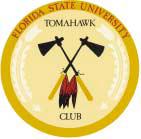FSU donors are a varied and generous support group
By Charlie Barnes, Executive Director - Seminole Boosters
Our entire fund-raising staff, all eight of us, spent an intense week in Atlanta calling on Boosters. We tried to concentrate on people we didn’t already know, on people who contribute money to the program from a long way away.
There are thousands of good Seminoles who may not be able to attend many games in Tallahassee or a bowl game, basketball tournament or baseball regional. But they give money to support Florida State and make all our programs stronger.
They’re not looking for a lot for themselves, and they’re surprised when someone calls in person and says thank you.
After Atlanta, we went to Dade and Broward Counties. Atlanta and South Florida are home to the largest concentrations of FSU alumni, and many thousands of fans and Boosters.
The populations are so huge, and the distances are deceiving on a map. Seminole Clubs in those areas sometimes find it hard to draw substantial crowds, because of the distances and the inclination of many to stay home after a long workday. That is understandable, and our volunteer Club leaders do a wonderful job of leading the faithful.
Even so, there are tens of thousands of good Seminoles, people with a great deal in common, who never see each other. What’s more, we have never met many of the donors to our athletic program.
We have nearly 16,000 active donors to the Annual Fund. Staying in touch with them, keeping them informed and being available to them is challenging.
The five-year Dynasty Campaign, concluded last October, produced an astonishing total of more than $76 million—from only about 160 people.
We concentrated on that very small universe of donors for five years. We’ll always focus on large, capital gifts. But now, our attention turns to our base of annual donors as well.
Most of the $76 million from the Dynasty Campaign is going to gorgeous new facilities at Florida State: our all-new Golf Center, the all-new basketball practice building, dramatically enhanced Dick Howser Baseball Stadium, an all-new Moore Athletic Center.
This entire park of first-class athletic facilities was created in only six years. That is a stunning accomplishment.
Now our attention turns to scholarships, which cost around $5 million a year, and every increase in tuition increases the cost.
The solution is an endowment large enough to produce the required amount in annual earnings. Projections show that means between $80 million and $100 million. That’s possible. We already have about $20 million in cash under management, with pledges for more.
Some schools are way ahead, but we can catch up.
The other main emphasis now for our staff will be increasing the number of annual donors, and strengthening the relationships between the Booster organization and our donors.
We have great supporters in equally great numbers. More than 3,000 individuals give at least $1,000 per year.
Last year, we had 613 Golden Chiefs ($5,500-$11,000), 574 Silver Chiefs ($2,750) and 1,824 Tomahawks ($1,100). Our minimum contribution for benefits is $55.
 |
 |
 |
Our staff looked at the numbers, studied the names and realized we have thousands of donors we have never met.
That was the inspiration for our trips to Atlanta and South Florida.
People were glad to see us, enthusiastic and happy to have their contributions appreciated. We’d talk about FSU sports and answer their questions as far as we were able.
We thanked them, and we asked for their help.
Everyone had questions.
Let me give you the good news as I told it to them.
We have the best fans, and the most generous. In the more than 25 years I have been with Seminole Boosters, we have never had a year in which the contributions were not greater than the year before.
Consider that FSU is one of only a very few schools whose football stadium averages more than 100 percent of capacity every season.
The 90 luxury boxes are all filled. We are adding seven this year, and they are already claimed.
One very large luxury box in the center of the stadium contains 238 seats, licensed in pairs to Golden Chiefs. There is a long and impatient waiting list.
The FSU Varsity Club is already the most successful varsity club at any major college or university.
The numbers of Seminole fans and the success of our athletic program are always growing.
Now here’s the other story, the reason we’re focusing on boosting our numbers.
Over the last 10 years, and especially during the last five, our total number of donors has dropped. To be sure, more than a little of this can be traced to our elimination of the $25 giving level. Our minimum gift today is $55 a year.
The amount of money we raise every year has increased, but the number of donors has dropped.
Now, it’s time to take back our standing as the largest collegiate booster club in America, and here’s why. We have always, at Florida State, been proud of the fact that we accomplish with numbers what other schools do with a few big donors. Our coaches brag to Seminole recruits that we have one of (used to be “the”) largest booster clubs in the country.
But here’s the most important reason, at least to me: I want to be able to look anyone in the eye and respond that this year we have raised more money than ever before, and we have more Boosters than ever before.
Seminoles don’t scatter. Never have. And I want to be able to make that very clear to all who wish it were otherwise.